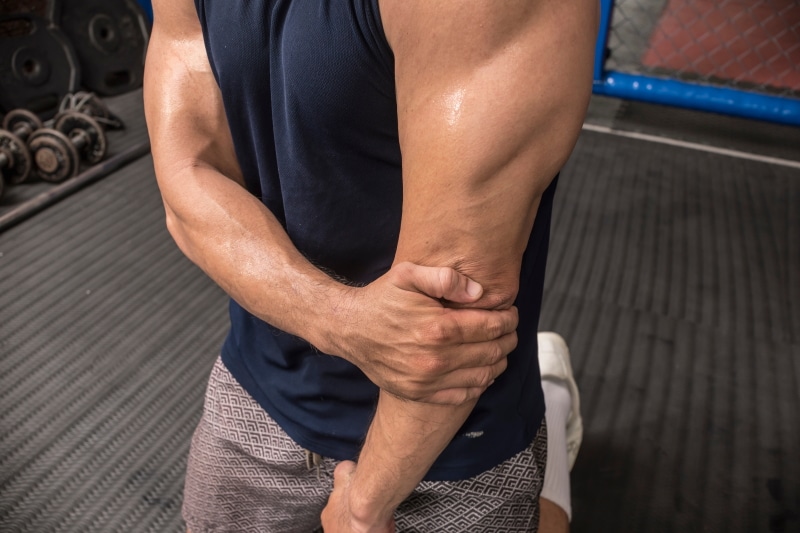This website uses cookies so that we can provide you with the best user experience possible. Cookie information is stored in your browser and performs functions such as recognising you when you return to our website and helping our team to understand which sections of the website you find most interesting and useful.

Triceps tendonitis can be caused by an injury that creates inflammation in the tendon connecting the muscle on the back of your arm (triceps) to your elbow bone. This condition is usually caused by overuse or injury during activities that involve repeated elbow extension. Sometimes excessive hammering, throwing a baseball, or doing bench presses can cause this type of injury.

Typically, it occurs due to overuse or repetitive stress on the triceps tendon, leading to microtears, inflammation, and pain. This condition is commonly seen in athletes who perform activities that involve repetitive or forceful elbow extension, such as weightlifting, throwing sports (e.g., baseball, football), racket sports (e.g., tennis, badminton), and activities that require repetitive pushing or pressing motions.
Some common causes and risk factors for triceps tendonitis include:
Overuse: Engaging in repetitive activities or movements that strain the triceps tendon, such as throwing, lifting heavy weights, or performing push-ups, can lead to tendonitis over time.
Poor Technique: Using improper form or technique during physical activities, such as weightlifting or sports, can increase the risk of triceps tendonitis by placing excessive stress on the tendon.
Muscle Imbalances: Weakness or imbalances in the muscles surrounding the elbow joint, including the triceps, biceps, and forearm muscles, can contribute to overuse injuries and tendonitis.
Age and Degeneration: As people age, the tendons in the body may become less elastic and more prone to injury. Degenerative changes in the tendon can increase the risk of tendonitis.
Trauma: Direct trauma or injury to the triceps tendon, such as a fall onto the elbow or sudden forceful impact, can lead to inflammation and tendonitis.
Repetitive Stress: Activities or occupations that require repetitive elbow movements or prolonged periods of elbow extension, such as painting, plumbing, or manual labor, can increase the risk of triceps tendonitis.
contact us at Fair Oaks Orthopedics. Our professional medical staff can help you simply by calling us today.

Symptoms of triceps tendonitis may include:
- Pain and tenderness at the back of the elbow, especially with movement or pressure on the tendon.
- Swelling and inflammation around the elbow joint.
- Stiffness or decreased range of motion in the elbow.
- Weakness or difficulty performing activities that involve elbow extension, such as lifting objects or straightening the arm.
Treatment for triceps tendonitis typically involves conservative measures to reduce pain and inflammation, promote healing, and prevent further injury. Some common treatment options may include:
Rest: Avoid activities that exacerbate symptoms and give the tendon time to heal.
Ice Therapy: Apply ice packs to the affected area for 15-20 minutes several times daily to reduce pain and swelling.
Anti-inflammatory Medications: Over-the-counter nonsteroidal anti-inflammatory drugs (NSAIDs) such as ibuprofen or naproxen may help alleviate pain and inflammation.
Physical Therapy involves rehabilitation exercises and stretches to improve the strength, flexibility, and stability of the triceps muscle and surrounding tissues.
Activity Modification: Modifying activities or using proper techniques to avoid excessive stress on the triceps tendon.
Bracing or Taping: Using supportive braces or taping techniques to reduce strain on the tendon during physical activities.
Steroid Injections: Corticosteroid injections may be considered in cases of severe pain or inflammation that does not respond to conservative treatments.
Extracorporeal Shockwave Therapy (ESWT): In some cases, ESWT may be used to stimulate healing and reduce pain in chronic tendonitis.
Surgery: Is rarely necessary for triceps tendonitis but may be considered in severe cases that do not respond to conservative treatments. Surgical options may include tendon debridement, tendon repair, or tenotomy (tendon release).
Surgical options may include tendon debridement, tendon repair, or tenotomy (tendon release).
Here’s a brief overview of each surgical option:
Tendon Debridement: Removing damaged or degenerated tissue from the triceps tendon alleviates pain and improves function. During the procedure, arthroscopic techniques (minimally invasive surgery with small incisions and a camera) are used to visualize the inside of the elbow joint and remove any scar tissue, calcium deposits, or other abnormalities contributing to tendonitis. Debridement helps promote healing and may be combined with other surgical techniques as needed.
Tendon Repair: In cases where the triceps tendon is partially torn or significantly damaged, tendon repair may be necessary to restore its integrity and strength. Dr. Pournaras may reattach the torn ends of the tendon using sutures or anchors and reinforce the repair with biological or synthetic grafts to enhance stability and promote healing. Tendon repair is typically performed using open surgical techniques, although arthroscopic methods may be used for select cases.
Tenotomy (Tendon Release): Involves cutting or releasing a portion of the triceps tendon to relieve tension and reduce pain associated with tendonitis. This procedure may be considered in cases of severe or chronic tendonitis that do not respond to conservative treatments. Tenotomy allows for decompression of the tendon and may be performed using open or arthroscopic techniques, depending on Dr. Pournaras’ preference and the specific characteristics of the injury.
The choice of surgical technique depends on factors such as the severity of the tendonitis, the presence of associated injuries or conditions, and the patient’s age and activity level.
Following surgery, rehabilitation, and physical therapy are essential to optimize healing, restore range of motion and strength, and facilitate a safe return to activity. Patients should follow their postoperative instructions closely and attend all scheduled follow-up appointments to monitor their progress and address concerns. With proper care and rehabilitation, most patients can achieve successful outcomes following surgical treatment for triceps tendonitis.
Mon 8:00 am – 4:30 pm
Tue 8:00 am – 4:30 pm
Wed 8:00 am – 4:30 pm
Thu 8:00 am – 4:30 pm
Fri 8:00 am – 4:30 pm
Sat Closed
Sun Closed

